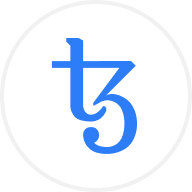Tezos is an open-source Proof of Stake (PoS) blockchain network that supports peer-to-peer (P2P) transactions between network participants and smart contracts. It was a pioneer of the decentralized governance model, which is now the preferred governance model in the blockchain industry. Tezos' mainnet launched in September 2018 following a record-breaking $228 million initial coin offering (ICO).
Tezos, also known as the "self-amending" blockchain, allows users to take on prominent roles in its governance system. At the same time, the network has established a more eco-friendly method of achieving network-wide consensus when validating transactions and implementing governance-related activities.
Change proposals can be made by any network participant who stakes (also known as "bake" in the Tezos ecosystem) a minimum of 6,000 XTZ tokens in a smart contract, which is then voted on by the community's "bakers." Each proposal is subjected to three rounds of voting before being tested for safety on a test network. If the proposal passes the test and still has a majority vote at the end of the voting period, it is added to the main network.
The idea behind this governance system was that it would allow the network to operate in a more decentralized manner than typical blockchain networks by requiring important change decisions to be voted on by network participants before being implemented. Furthermore, such a governance system may reduce the likelihood of a blockchain being forked.
XTZ price and tokenomics
XTZ is an inflationary currency without a supply cap. Approximately 80 new XTZ tokens are issued every minute, giving it an annual inflation rate of around 5.4 percent. Given that more tokens are constantly being added to the supply, the XTZ price may fall over time. To avoid this, the team has devised methods for permanently removing XTZ from the circulating supply.
Notably, the protocol slashes and burns a portion or all of the staking capital of bakers found to be acting maliciously. Furthermore, XTZ is burned whenever a KT1 account or a smart contract for holding delegated XTZ is created.
Despite the large number of XTZ tokens in circulation, only a small number of XTZ tokens are available to the public because nearly 80 percent of XTZ tokens in circulation had been locked up to earn staking rewards as of April 2021.
XTZ distribution
Following the launch of the Tezos mainnet, a total of 763,306,929.68 XTZ tokens were issued and distributed as follows:
- 79.59 percent of the supply was shared among ICO participants
- 0.41 percent went to early supporters, advisors, contractors, and backers
- Dynamic Ledger Solution claimed 10 percent of the supply
- 10 percent went to the Tezos Foundation
About the founders
Tezos was founded by Arthur and Kathleen Breitman, a husband and wife team who both worked in finance. Arthur, who had a background in math and computer science, worked in quantitative finance at Morgan Stanley, while Kathleen was a hedge fund consultant. Tezos was proposed by the duo in 2014, and development began through Dynamic Ledged Solutions Inc, a startup founded in 2015 to develop the Tezos platform.
The Tezos Foundation was founded in 2016 with the help of Johann Gevers to support the promotion and development of the Tezos blockchain. In June 2017, in collaboration with the Tezos Foundation, the Brietmans conducted one of the most successful ICOs ever. By the end of the ICO, the project had raised approximately $232 million in Bitcoin and Ethereum. However, the distribution of tokens to investors took longer than expected due to a series of internal disputes between the Breitmans and Johann Gevers, the then-president of Tezos Foundation.
In September 2018, following the resignation of Gevers and another board member of the Tezos Foundation, the mainnet version of the Tezos blockchain was launched.
Ever since it officially went live in 2018, Tezos has looked to partner with crypto firms and brands well known to the average internet user. One of Tezos's most prominent partnerships is its deal with McLaren Racing. In June 2021, McLaren Racing announced that Tezos has emerged as its official blockchain partner. The British motor racing team revealed plans to create an exciting fan experience via NFT technology provided by Tezos.
In addition to the McLaren Racing partnerships, Tezos has secured deals with other high-profile brands, including Red Bull, Manchester United, Ubisoft, and Team Vitality.
Tezos highlights
Tenderbake upgrade
The Tezos blockchain received a significant upgrade in April 2022. The Ithaca 2 upgrade changed the blockchain protocol's mining algorithm from the previous "Emmy" to the new Tendermint-inspired "Tenderbake," with the goal of shortening block times, speeding up transactions, and making applications run more smoothly on the platform. Ithaca 2 also included new network-scalability features such as rollups for Ethereum Virtual Machine (EVM) and WebAssembly compatibility. The upgrade also reduced the amount of XTZ tokens required to become a baker from 8,000 to 6,000.
Rarible integration
Rarible, one of the world's largest non-fungible token (NFT) marketplaces, integrated its platform with the Tezos blockchain in December 2021, making Tezos the third blockchain it integrated with. Tezos-native NFTs can now be traded on Rarible thanks to the integration. To commemorate the occasion, Rarible and Tezos launched an inaugural NFT collection called Blazing Futures.
Manchester United sponsorship
On February 10, 2022, European soccer club Manchester United, one of the world's largest soccer clubs, announced a multi-year sponsorship agreement with Tezos that will see the Tezos brand name featured on their range of training kits. The contract is said to be worth $27 million per year. Tezos had previously signed similar deals with Formula One's McLaren Racing and Major League Baseball's New York Mets.




















Socials